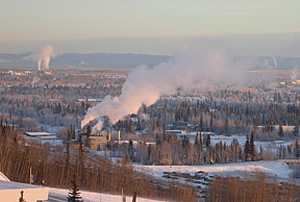The price of oil and poor air quality
The price of oil and poor air quality
Submitted by Ned Rozell
Phone: 907-474-7468
12/05/08

Established by people like gold miners who had other things on their minds, many Alaska cities, towns, and villages are in places with hidden issues. Fairbanks, for example, is in a valley so windless that air parcels linger there for long periods of time. Add about 100,000 people and their emissions, and that box of air can get stagnant.
In early winter 2008, Fairbanks has had some of the worst air quality ever recorded, according to Jim Conner, an air quality specialist for the Fairbanks North Star Borough.
"We exceeded (federal air quality) standards in October this year for the first time," Conner said. "It looks like we’ll have twice as many exceedances this year, about 50 (days)."
The bad air, caused by tiny floating particles from burned fuels, will lead to the Environmental Protection Agency in December to declare the borough as "out of attainment" of the National Ambient Air Quality Standards. This means that Alaskans will have three years to come up with a plan on how to solve Fairbanks’ air problems, or the federal government will draw up a plan for Fairbanks.
Health officials are most concerned with pollutants in air smaller than 2.5 micrograms, about the size of bacteria or 1/50th the width of a human hair. Those specks are small enough that they travel past your nose and trachea and deep into your lungs. Conner and his colleagues are now measuring Fairbanks air around the clock at certain places and are employing people to drive around with air sensors. They want to fingerprint the sources of fine particulates in Fairbanks.
Though results from the borough studies aren’t all in yet, Conner said he suspects that the high price of oil last spring and summer have driven more people to burn wood and coal. People have fired up old wood stoves that aren’t as clean-burning as new ones, and many people invested in outdoor wood and coal boilers, which tend to smolder rather than burn hot and clean, and have smoke stacks that extend not much higher than a person is tall.
"We’ve been seeing these things one-quarter mile away with our instruments," Conner said of the boilers. "We estimated about 1,500 of these were sold this summer, so that’s a lot of half-mile zones affected in Fairbanks.
"These boilers were designed for rural use, to be put 500 feet away from the nearest structure, but people are putting them on one-quarter acre lots," Conner said.
Oil furnaces, cars, and emissions from coal-fired power plants are other parts of the Fairbanks air-quality equation that borough employees are trying to solve, along with people from the city government, the state Department of Environmental Conservation, the University of Alaska Fairbanks and its Cold Climate Housing Research Center, and the Environmental Protection Agency.
Possible solutions with the wood-and-coal burning issue are new laws prohibiting burning on certain days (sometimes enforced in Juneau’s Mendenhall Valley, which has similar-though-less-extreme atmospheric conditions in winter) and finding a way to tidy up existing systems. Conner said he realizes that people have invested thousands of dollars into new boiler systems, and aren’t likely to abandon them.
"Speaking for the borough, we don’t want to stop everybody from using this equipment, but we want to try to make it as clean as possible," Conner said.
This column is provided as a public service by the Geophysical Institute, University of Alaska Fairbanks, in cooperation with the UAF research community. Ned Rozell is a science writer at the institute.


